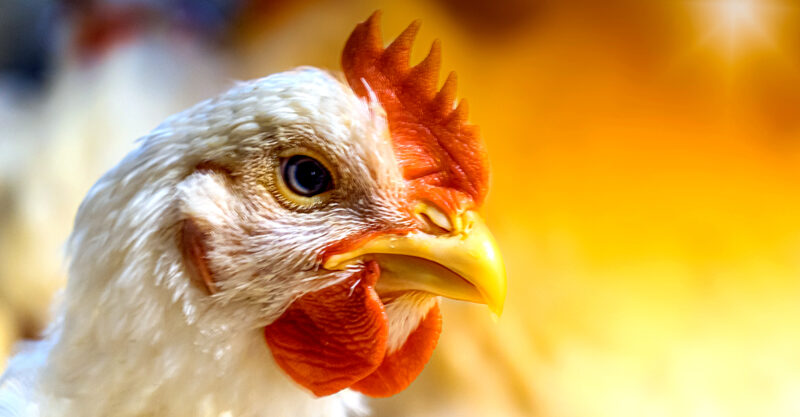Miss a day, miss a lot. Subscribe to The Defender's Top News of the Day. It's free.
It’s not your imagination — U.S. chickens are gigantic.
In the 1920s, an average chicken weighed 2.5 pounds and took 12 weeks to reach that weight, according to a 2021 Bloomberg report.
Today’s chickens clock in at more than 6 pounds — and they reach that weight in just seven weeks.
The National Chicken Council (NCC) credits better breeding, healthier nutrition and feed, “regular veterinarian oversight and the use of vaccines to prevent disease,” for the growth explosion.
The NCC also assures consumers that hormones, steroids and genetic engineering have nothing to do with the outsized chickens produced on industrial poultry farms.
Antibiotics? That’s another story, according to the NCC, which calls them “just one of many tools farmers use to keep their flocks healthy, in order to contribute to a safe and wholesome food supply.
“[J]ust like people, animals sometimes get sick, and treating illness is a responsible part of animal care,” the NCC states on its website.
The NCC statements imply that the use of antibiotics on industrial chicken farms is a rare occurrence, limited to instances when an animal “sometimes gets sick.”
But that’s misleading — antibiotic use is integral to industrial chicken farming and factory farming in general.
Today’s intensive, industrial chicken operations use antibiotics to prevent infection in crowded conditions and add weight on birds without feeding them more, according to The Humane League.
A 2014 Reuters investigation found that after U.S. Food & Drug Administration (FDA) enacted guidance restricting the use of antibiotics, Tyson Foods, Pilgrim’s Pride, Perdue Farms, George’s and Koch Foods were using antibiotics “more pervasively than regulators realize.”
Pilgrim’s Pride’s feed mill records showed the antibiotics bacitracin and monensin were being added “to every ration fed to a flock grown early this year,” reported Reuters.
Koch Foods, a supplier to Kentucky Fried Chicken restaurants, also was caught using routine antibiotics — and denying it on the company website.
How dependent are “factory farmers” on antibiotics for their bottom line?
Without antibiotics, 175,550 more tons of feed would be needed to grow U.S. turkeys, said Michael Rybolt of the National Turkey Federation when the FDA tried to limit their use in 2008. “If we did not have the use of antimicrobials … we would have a decrease in feed efficiency so we would have a decrease in utilization of the nutrients.”
How do antibiotics, also called antimicrobials, add weight using the same amount of feed and help operators’ bottom line?
An article in the journal Gut Microbes suggests antibiotics cause “enhanced energy harvest from dietary intake, due to an alteration in microbial composition” — and also may affect “host energy regulation” and the immune system.
Antibiotics may similarly cause human weight gain, researchers speculate, as low-level exposure has become so common.
Thomas Jukes of Lederle Laboratories (since acquired by Wyeth and later by Pfizer) discovered the growth function of antibiotics in chicken in 1948, according to Maryn McKenna, author of “Big Chicken.”
Antibiotics were so much a part of early chicken production, the birds were actually soaked in them to leave a protective film in a process called acronizing, McKenna said. Some of the workers performing the acronizing, whose hands were in constant contact with the drugs came down with staph infections.
Does your chicken look like spaghetti?
Fast-growing, 6-pound chickens may be a boon for poultry producers but they raise health, safety and ethical questions.
For example, intensive chicken farming produces diseases called myopathies that affect the birds’ muscles, according to research published in Poultry Science.
These myopathies include “spaghetti meat,” “woody breast” and “white striping” — unappetizing conditions that affect breast muscle and that are “characterized by a loss of myofibers and an increase in fibrous tissue,” write the researchers.
Chicken fillets with spaghetti meat showed “soft and friable when palpated and showed separation of myofiber bundles affecting primarily the cranial area of the breast muscle, starting from the superficial layer,” when examined by Poultry Science researchers.
According to the researchers:
“Fillets with WB [woody breast] had a tougher texture, were often pale, and sometimes showed petechial hemorrhage and edema on the surface. Areas of tougher texture could be localized and/or diffuse. Occasionally, fillets with severe WB were presented with multifocal areas of increased thickness (bulging) on the cranial or caudal area.
“Breasts affected by WS exhibited white lines parallel to the myofibers, most frequently affecting the cranial area of the fillet and rarely extending to the caudal area.”
In 2019, the animal welfare group Animal Equality flagged the conditions that consumers may not have associated with the fast growth — conditions that create image problems for chicken producers when consumers encounter them or read about them in articles by Bloomberg and Vice.
The NCC acknowledges “woody breast” but dismisses it as affecting a “small percentage” of birds and not creating “health or food safety concerns” for humans.
Moreover, the NCC also rejects the suggestion by Poultry Science researchers that these conditions are linked to intensive farming, stating on its website that “the causes of “woody breast” are not known at this point.”
On the human health front, fast-growing mega-chickens aren’t as nutritious as their predecessors according to some reports.
“Today, you’d need to eat six CAFO [concentrated animal feeding operation, or factory farm] chickens to get the same amount of omega-3 fats found in a single chicken raised in the 1970s,” according to natural health expert Dr. Joseph Mercola.
Omega 3 fats are credited with reducing unhealthy triglycerides, slowing the development of plaque in the arteries and providing other health benefits.
Bigger isn’t better for chickens or humans
Rapid growth isn’t any better for chickens’ health than it is for human health — for starters, they’re at risk of “sudden death syndrome” according to the Merck Veterinary Manual.
Also called “flip-over disease,” the condition causes birds with “no specific gross lesions” to die from a “short, terminal, wing-beating convulsion,” the manual states.
“The modern broiler, which has been selected for growth rate and feed conversion efficiency, has a predisposition to cardiac arrhythmias,” states the manual. “Incidence can be minimized by slowing growth rate in broilers.”
A study of 7,500 chickens at the University of Guelph in Ontario, Canada, cited by The Counter in 2020, “found the fast-growing birds had higher rates of ‘footpad lesions’” than slower-growing birds, and “higher concentrations of biochemicals associated with muscle damage, heavier hearts, and lighter lungs. These indicators suggest strained muscles and potential organ issues.”
Commenting on the study, Leah Garcés, president of Mercy for Animals, said fast growth breeds “pain and suffering.”
Rather than deny how big contemporary chickens have grown and how fast they are growing on intensive farms, the NCC plays the environmental card.
The NCC states:
“Most of the chicken available in the stores today comes from flocks that grow to market weight in about 48 days on average, using fewer natural resources — therefore more sustainably. Compared to 25 years ago, today’s chickens now require seven percent less feed per pound to grow. Considering our national broiler flock eats about 57 million tons of feed per year — that is a lot of resources saved.”
On the other hand, NCC said, “Slower growing chickens require more feed, fuel, water and land per pound of meat to sustain their growth.”
The Council also plays the “humane card,” claiming “[L]eg problems, due to the growing weight of a modern broiler chicken, are much less prevalent than they were 20 years ago because farmers and breeders began selecting them for leg strength and overall skeletal health.”
The Humane Society, however, disagrees. “During the last days of their lives, about a third of broiler chickens suffer leg problems so severe they struggle to walk.”
According to the group’s website, employees “move through buildings to collect dead birds and break the necks of lame ones. Survivors huddle on the floor, trapped by their own bodies. Unable to escape the pain, they lie in litter strewn with their own waste. Ammonia burns their breasts and often blisters their skin and feet.”
The two pictures of modern chicken farming could not be more different.
The council also defends the gigantic, fast-growing chickens as an economic improvement — they are “consumer-friendly because fewer “resources” are required make them cheaper compared to slow-growing chickens, which are “typically 3x more expensive than their counterparts.”
The availability of so much fast-growing chicken meat has made chicken the most popular meat consumed in the U.S. — and one of the cheapest.
Yet if the meat is riddled with myopathies, has less nutritional value and the birds suffer greatly, who benefits?





